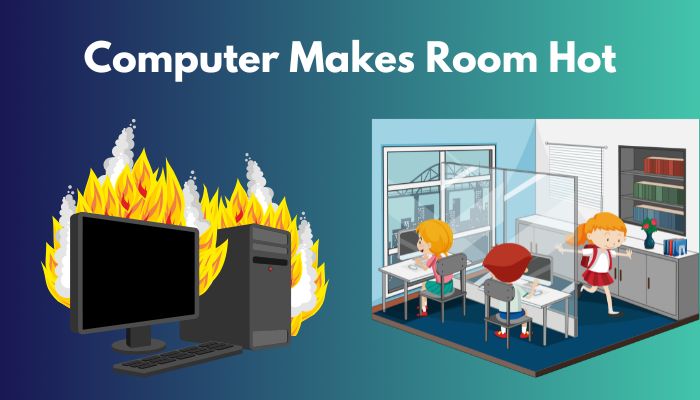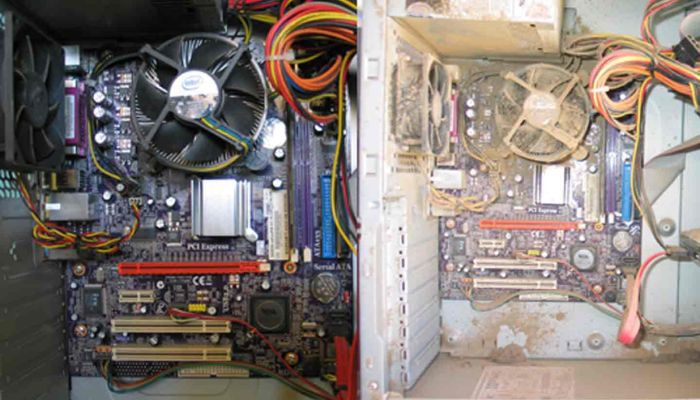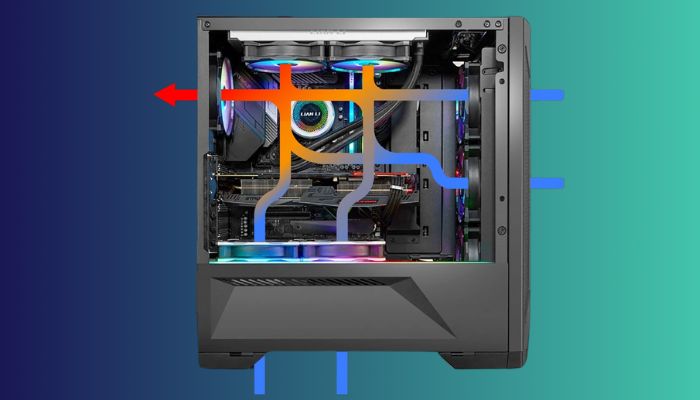Running your computer at full throttle and feeling a warm sensation than usual? No! It’s not a supernatural force; your system is making the surroundings hot.
As per the law of thermodynamics, emitted heat from the PC will gradually raise the room’s temperature by a few degrees.
In winter, your body endures the heat efficiently, but in the summer season, it is oddly annoying.
You are probably wondering about cooling down your room while running your beastly rig.
Buckle up and keep reading this fantastic editorial.
Why Does Computer Make Room Hot?
Your computer makes the room hot primarily due to poor ventilation inside the room and the PC. Intake fans pull fresh and cool air inside the rig, and your system’s exhaust fans push warmer air out. Fans cannot pull cool air if the computer is placed in a congested area with no breathing room.
You see, the air inside the PC case gets warmer when the airflow is hampered. As a result temperature inside the case rises and circulates to each corner of the room.
Here are the most common reasons why computer makes the room hot:
Terrible Ventilation of Air Inside Room and Computer
You’ve probably heard about the importance of airflow inside the computer. If not, well, now you know. However, poor air ventilation can be a culprit why you are suddenly feeling hot in your very own room.
The temperature inside the computer rises if the intake and outtake fans can not move air.
Say you have a PC case that has a small number of cut-outs or vents for airflow. Regardless of the fans’ power, they can not pull or push air through these vents efficiently. Can you see why it’s too hot inside your computer?
You understand your PC is generating all the heat but wondering, “What is it to do with my cozy room?”
Well, the heat technically may reside inside the room, although your PC can push hot air out of the case. If your room has enclosed windows and no direct airflow, temperatures rise with time.
Many people place their computers in tiny and tight spaces, surrounded by obstacles such as walls or furniture. Consequently, system intake fans push out hot air, but the lack of cool air in the congested spot lets intake fans pull the same air.
After some time, heat spreads to the entire room, making it hot.
Related guide about how much energy does gaming computers use.
Dirt and Dust Inside the Computer
Air has dirt and dust by default. PC case manufacturers are well aware of this. They make dust filters and place them in places from where the air is pulled in.
Dust filters separate dust from the air and only let the pure fresh air in.
Brilliant right? Well, it prevents dust from building up inside the components to some degree. But the pores on the filter get blocked by dirt over time. Apparently, airflow takes a hit, and temp inside of the PC rises.
Unsound Fans
Fans and coolers of a rig are responsible for the temperature. Good quality fans and coolers are necessary to keep the heat generation in check.
Nothing lasts forever. And fans and coolers are no exception.
The bearing inside the fan wears up after prolonged usage. It fails to move air. You may think it’s working fine as it spins, but the capability of driving air from the case drops significantly.
Place your hand in the fan’s exhaust direction and feel the air pressure. You will notice a light force of the air hitting your hand.
Faulty fans of different components such as power supply fan help to generate heat.
Defective Coolers
Cooler efficiency drops as well with time. Heat dissipation capability drops, and the ambient inside and outside of the PC gets warm.
An all-in-one water cooler has higher heat dissipation capability than air coolers. The pump inside the water cooler may get jammed due to debris. As a result, it can not reduce heat from the surface of the CPU.
During the manufacturing process, water inside the cooler may have foreign particles which hinder the cooler’s performance.
Radiators of the water cooler can also fail. An external hit on the radiator can leak it severely and ruin the cooler.
The air cooler’s metal fins gather dust after long usage. As a result, air cannot pass through these fins, and heat builds up inside the rig.
Thermal Paste Dried Out
The thermal paste helps to transfer heat from the surface of the CPU or GPU dye to the cooler. It primarily fills the gap between the chip IHS and the cooler surface.
As both of the surfaces are metal, they have microscopic unevenness. When two uneven surfaces come into contact, they cannot transfer heat properly. Hence, come in the thermal paste.
Thermal paste has heat conductivity properties but is electrically non-conductive.
After an extended period, the thermal paste becomes dry and can not transfer heat.
But before that, go through our epic guide on access advanced bios settings in hp computers.
How to Fix Computer Makes Room Hot
You can easily fix your computer getting hot while playing games and intensive tasks by ensuring proper ventilation inside the PC case and the room.
Making changes in your room’s arrangements, replacing coolers, adding more fans etc. help to cool down your computer room.
Here are the methods to keep your computer room cool:
1. Increase Airflow Inside the PC
The idea behind increasing airflow inside the rig is relatively simple. You need to push out hot air and take in cool air from outside the PC case.
To achieve this goal, you need to add some extra bit of accessories and some modifications.
Here are the steps to increase airflow inside the PC:
- Add good quality case fans. Try to achieve neutral air pressure or at least positive. Calculate total CFM of intake and outtake fans.
Subtract total outtake CFM from intake CFM. Positive, zero and negative value refers to their respective air pressure.
Air Pressure = Total Intake CFM – Total Outtake CFM.
- Replace the case’s front panel if it is enclosed and has no air vents. You can easily buy them online.
- Clean the dust filters and fans thoroughly and ensure air passes through them. Clean the entire case as well.
You will notice a significant amount of air flowing through the PC.
Follow our guide for buying a used computer what should you look for?
2. Make Changes in the Room
Room arrangements play a critical role in maintaining the temperature. The lack of fresh and cool airflow makes the room hotter while running the computer.
Here are the things you must keep in mind while making changes in the room:
- Keep your rig in a spacious place.
- Keep your PC close to the AC if you have one.
- Install thermal curtains to prevent sunlight from getting into the room.
- Open all the windows in your room to let fresh air come from outside.
- Move any device that generates heat away from the computer.
- Install a custom water loop and keep the radiator outside of the room. It requires some re-construction process.
Once you modify your room with the steps mentioned above, you will notice a big difference in room temperature.
3. Re-apply Thermal Paste
It’s a good practice to change thermal paste every 8-12 months. The thermal paste dries up with usage. Paste from a good company can last more than a year.
Here is the procedure to change thermal paste:
- Disconnect the rig from any power source.
- Remove the side panel of your computer.
- Gently lay your PC down to access the cooler easily.
- Remove all the screws holding the cooler on the motherboard. Follow the cross pattern while unscrewing. It will put pressure evenly on the motherboard.
- Give the cooler a gentle twist, then pull. It will come off.
- Clean existing thermal paste on the top of the Processor and the contact surface of the cooler with a tissue or isopropyl alcohol.
- Apply a small amount of paste to the processor’s IHS. (Integrated Heat Spreader).
- Place the cooler correctly and screw the 4 corners. Thermal paste underneath will spread across the processor’s IHS.
Turn on your PC and monitor temp. You will see a significant drop in temp.
4. Install New Cooler and Fans
It is expected that the fans and coolers inside the computer will wear out gradually. So you need to replace them if the performance drops significantly.
Observe the temperature patterns while doing any resource-intensive task and gaming. There are many free wares you can install to monitor PC’s temperature.
Usually, after re-applying thermal paste, if you see your system temperature hovering around 80-90 degree celsius, you probably need to replace your cooler and fans.
To confirm, install your cooler in a different system and see if it works.
Read more on why is my computer buzzing?
FAQs
Do computers Heat up Rooms?
Yes, computers can heat up rooms. In a room of 190sqft, a PC can raise the temp to about 4 degrees if it runs for 12 hours.
How Do I Stop My Computer from Heating up the Room?
Increase the airflow of your room and the computer to stop your computer from heating up the room. You can also install AC in your room to keep it cool.
How to Keep Room Cool with Gaming PC?
You can keep your room cool with a gaming PC by maintaining proper ventilation. Cleaning your PC regularly and re-pasting the CPU and GPU can help as well.
Ending Note
The heat emitted from the PC annoys the user in a prolonged session. In summer, a few degrees increment feels like living in hell.
In my experience, ensuring proper room ventilation and adding exhaust fans at the back of the case greatly reduced heat.
Comment on this thread and let us know the update.



